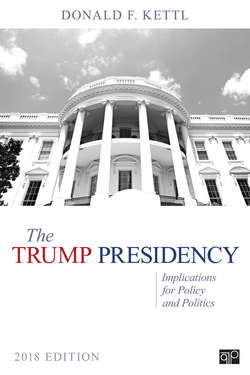Читать книгу The Trump Presidency - Donald F. Kettl - Страница 7
На сайте Литреса книга снята с продажи.
Making America Great Again
ОглавлениеIf the goal was to make America great again, just when was America great? In an interview with the New York Times, Trump pointed to the beginning of the twentieth century—and then again to the end of World War II, in the late 1940s and early 1950s.5 Many Americans pick other periods. According to a Morning Consult poll conducted for the New York Times, Americans tend to think that the time when the country was “great” was at the end of the 1990s. Trump supporters, in general, tended to agree, though they also were fond of 1955, 1960, 1970, and 1985. (See Figure 1.)6
A man holds a “Make America Great Again” sign as supporters of U.S. president Donald Trump and his policies demonstrate during a “Pittsburgh Not Paris” rally next to the White House in Washington, D.C., on June 3, 2017, in support of his decision to withdraw the United States from the Paris Climate Accord.
SAUL LOEB/AFP/Getty Images
Figure 1 Growth in Income, before Taxes, 1979–2013 (dollars are inflation-adjusted)
Source: Congressional Budget Office, The Distribution of Household Income and Federal Taxes, 2013 (June 2016), https://www.cbo.gov/sites/default/files/114th-congress-2015–2016/reports/51361-HouseholdIncomeFedTaxes_OneCol.pdf
A reporter from The Atlantic decided to dig even deeper into the data and found that when America was “great” depended on when people were born. Americans born in the 1930s, 1940s, and 1950s thought America was great in the 1950s. For those born in the 1960s and 1970s, it was the 1980s. For those born in the 1980s and 1990s, the 1990s held the biggest sway (Table 1). The 1960s and the 1970s, with the Beatles and disco, were no one’s first choice.
Source: Data from: Andrew McGill, “Just When Was America Great?” The Atlantic (May 4, 2016), https://www.theatlantic.com/politics/archive/2016/05/make-the-sixties-great-again/481167/
“Making America great again,” of course, is about much more than nostalgia. It’s about rediscovering a sense of optimism and security, about opportunity and identity. And that’s the message that Trump sought to deliver in the campaign. Tapping into Americans’ concerns was a large part of his electoral success. Perhaps no bigger concern was the widening income gap: the richer are getting richer, while the income of almost everyone else is barely rising. As Figure 1 shows, the income of the bottom 20 percent of the nation’s wage earners has been flat for the last thirty-five years. The income of the next 60 percent of individuals has gone up 32 percent, after accounting for inflation. For those in the top 20 percent, incomes have gone up dramatically: 187 percent. Economists debate about the cause of this widening gap. Regardless of the technical explanations, however, voters sense the change. Most of them are furious, frustrated, or both. And Trump tapped into those feelings, especially with his stands on immigration.
